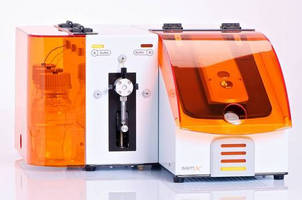Pressure Sensors / Detectors / Transducers
Multichannel Acoustic Biosensor has adapable microfluidic routing.
Share:
Press Release Summary:

Able to expand capabilities for studying real-time kinetics on surfaces of live mammalian cells, sam®X sensor uses surface acoustic wave technology and does not require any fluorescent labeling. Each of 8 channels can be utilized independently (8 x 1) or via sequential combinations of 4 x 2, 2 x 4, or 1 x 8 channels to optimize workflow; discrete or common reagents can be delivered to particular sensor chip positions. Analysis takes place in minutes.
Original Press Release:
SAW Instruments Launches NEW sam®X Acoustic Biosensor in US at IBC's Antibody Engineering Meeting 2011
A Powerful and Flexible Multi-Channel Platform Optimised for Mammalian Cell Binding Workflows
San Diego, CA, USA: SAW Instruments, a global developer and provider of innovative biosensor technology for life sciences research in biotech and academia, has launched the sam®X acoustic biosensor in North America at the IBC Antibody Engineering and Antibody Therapeutics (AEAT) meeting in San Diego, CA, USA (4-8 December 2011). sam®X is the latest high-end addition to the sam® range of acoustic biosensors, featuring eight analysis channels and adaptable microfluidic routing that expands the capabilities for studying real-time kinetics on the surfaces of live mammalian cells. The new system uses SAW Instruments' proven proprietary Surface Acoustic Wave (SAW) technology, which can detect both mass binding events and protein conformational changes, and represents a step-change in biosensor technology and applications. Unlike other cell-based detection platforms, SAW Instruments' range of sam® acoustic biosensors do not require any fluorescent labelling, are real-time rather than steady-state, and can use unfixed cells adhered to the sensor surface or in suspension, all while providing rapid analysis in the order of only a few minutes.
The new sam®X offers increased throughput with two sensor chips, rather than the single chip of the sam®5 models, which increases the number of channels to eight. Using sophisticated fluidics, each channel can now be utilised independently (8 x 1) or via sequential combinations of 4 x 2, 2 x 4, or 1 x 8 channels. This optimises user workflow, allowing discrete or common reagents to be delivered to particular sensor chip positions. In addition, different ligands can now be immobilised on-line at each chip position automatically, without the need for time-consuming, off-line protein loading. This approach is important for directly quantifying the amount of protein bound to the sensor chip surface, giving even more accurate and reliable results.
Dr Markus Perpeet, Managing Director of SAW Instruments, commented: "We are very excited to introduce North American scientists to the sam®X, which further opens up new potential applications for biosensors, the type of which are way beyond what was previously possible with SPR. The new system facilitates more complex assay design and can be easily adapted to meet the needs of each user, while increasing throughput speed and accuracy. It is particularly well suited to measuring binding constants and kinetics for proteins on whole mammalian cells. It could also be used to investigate relative antibody accessibility to native membrane protein structures via assessment of the kon kinetics data provided using SAW technology. Importantly, results are obtained significantly faster than when using equilibrium-based methods."
SAW Instruments are exhibiting at AEAT booth #212 and are also presenting a poster, entitled "Binding Kinetics of Therapeutic Antibodies to Native Proteins on Living Cells". Visit the booth to see the sam®X in action and to find out more about SAW Instruments' current price offer, which is available for a limited time only!
For more information on the sam®X and other sam® systems, visit www.saw-instruments.com
Notes on the technology
Surface Acoustic Wave technology is based on the ability of a wave of energy to travel across the surface of a material. Each surface has a typical inherent elasticity affecting the way the energy of the wave dissipates as it travels across the surface of the material being analysed. Thus, the nature of the surface in question, and therefore any changes to it, can be assessed by sensors monitoring the behaviour of the wave as it propagates across the surface. In particular, changes in mass result in alterations to the phase of the wave, whilst viscoelastic and conformational characteristics influence wave amplitude. The technology developed and employed by SAW instruments is capable of accurately interpreting this information in order to provide real time readouts measuring binding and conformational changes in the samples through which the wave passes.
About SAW Instruments GmbH
SAW Instruments GmbH designs, develops and sells biosensor-based laboratory instruments for life sciences research. The proprietary technology of SAW Instruments employs a Surface Acoustic Waves approach to biological measurement, rather than using traditional optical methods such as SPR. The technology is uniquely positioned compared to other biosensor technologies based on its ability to measure conformational changes in cells, membranes and vesicles. In addition, the system is also capable of providing other industry standard measurements including those involving kinetics, quantitation and affinity.
SAW instruments has more than ten years experience in the field of label-free biosensor technology and a number of our customers have successfully published work employing the platform. It is our goal is to continue to build on this experience, as well as to develop a family of workflow-driven products to further meet our customers' needs.




